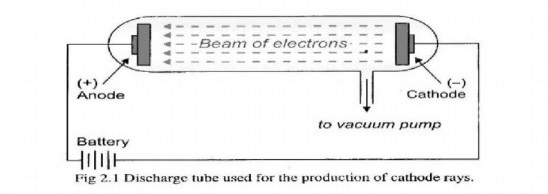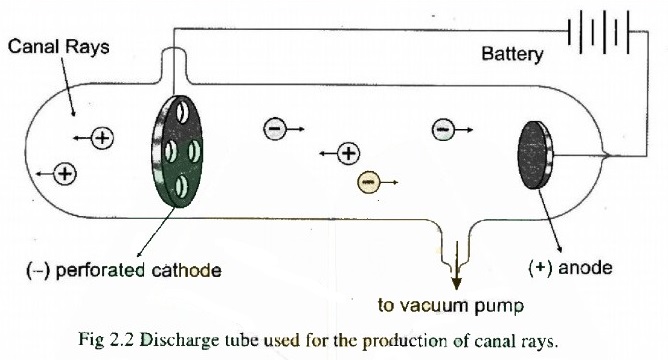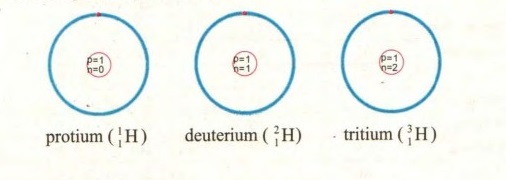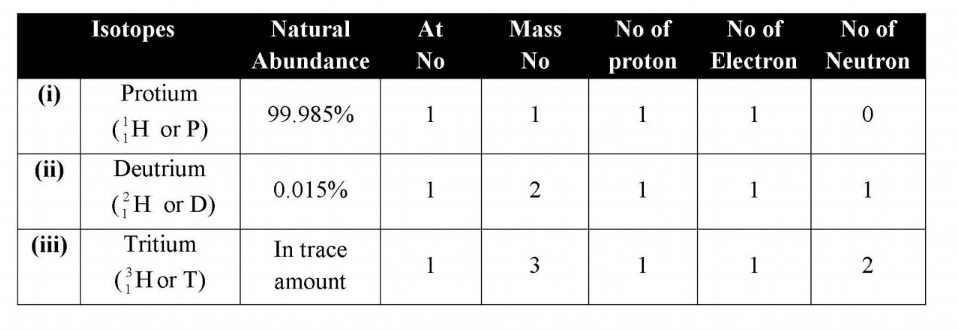Unit 2 – Structure of Atoms (Long Questions)
Q.1 How are cathode rays produced? What are its five major characteristics?
Q.2 How was it proved that electrons are fundamental particles of an atom?
Q.3 Draw a labeled diagram to show the presence of protons in the discharge tube and explain how canal rays were produced.
Q.4 How Rutherford discovered that an atom has a nucleus located at the center of the atom?
Q.6 How did Bohr prove that an atom must exist?
Q.7 What do you mean by electronic configuration? What are basic requirements while writing electronic configuration of an element (atom)?
Q.8 Describe the electronic configuration of Na, Mg2+, and Ap+ ions. Do they have the same number of electrons in the outermost shell?
Q.9 Give the applications of isotopes in the field of radiotherapy and medicines.
Q.10 What is an isotope? Describe the isotopes of hydrogen with diagrams.
Q.1 How are cathode rays produced? What are its five major characteristics?
Answer:
Cathode rays and discovery of electron:
Introduction
In 1879 Sir William Crooks performed experiments by passing an electric current through gases in a discharge tube at very low pressure.
Experiment:
He took a glass tube fitted with two metallic electrodes, which were connected to a high voltage battery. The pressure inside the tube was kept 104 atm. When a high voltage current was passed through the gas, shiny rays were emitted from the cathode surface move towards the anode as shown in figure 2.1.
Name Reasons:
These rays were given the name of ‘cathode rays’ as these were originated from the cathode.

Properties of cathode rays:
The major characteristics of cathode rays are given below:
i. Traveling in a straight line: These rays travel in a straight line perpendicular to the cathode surface.
ii. Costing of shadow: They can cast a sharp shadow of an opaque object is placed in their path.
iii. Deflection in an electric field: They are deflected towards a positive plate in an electric field showing that they are negatively charged.
iv. Rise in temperature: They raise the temperature of the body on which they fall.
v. e/m ratio: J.J. Thomson discovered their charge/mass (e / m) ‘ratio:
vi. Production of light: Light is produced when these rays hit the sides of the discharge tube.
vii. Nature of cathode: It was found that the same type of rays was emitted, no matter which gas and which cathode was used in the discharge tube.
Conclusions:
i. All these properties suggested that the nature of cathode rays was independent of the nature of the gas present in the discharge tube or material of the cathode.
The fact that they cast the shadow of an opaque object suggested that these are not rays but they are fast-moving material particles. They were given the name electrons.
ii. Since all the materials produce the same type of particles, it means all the materials contain electrons.
iii. As we know materials are composed of atoms, hence the electrons are fundamental particles of atoms.
Q.2 How was it proved that electrons are fundamental particles of an atom?
Answer:
Cathode rays and discovery of electron:
Introduction
In 1879 Sir William Crooks performed experiments by passing an electric current through gases in a discharge tube at very low pressure.
Experiment:
He took a glass tube fitted with two metallic electrodes, which were connected to a high voltage battery. The pressure inside the tube was kept 104 atm. When a high voltage current was passed through the gas, shiny rays were emitted from the cathode surface move towards the anode as shown in figure 2.1.
Name Reasons:
These rays were given the name of ‘cathode rays’ as these were originated from the cathode.

Properties of cathode rays:
The major characteristics of cathode rays are given below:
i. Traveling in a straight line: These rays travel in a straight line perpendicular to the cathode surface.
ii. Costing of shadow: They can cast a sharp shadow of an opaque object is placed in their path.
iii. Deflection in an electric field: They are deflected towards a positive plate in an electric field showing that they are negatively charged.
iv. Rise in temperature: They raise the temperature of the body on which they fall.
v. e/m ratio: J.J. Thomson discovered their charge/mass (e / m) ‘ratio: vi. Production of light: Light is produced when these rays hit the sides of the discharge tube.
vii. Nature of cathode: It was found that the same type of rays was emitted, no matter which gas and which cathode was used in the discharge tube.
Conclusions:
i. All these properties suggested that the nature of cathode rays was independent of the nature of the gas present in the discharge tube or material of the cathode.
The fact that they cast the shadow of an opaque object suggested that these are not rays but they are fast-moving material particles. They were given the name electrons.
ii. Since all the materials produce the same type of particles, it means all the materials contain electrons.
iii. As we know materials are composed of atoms, hence the electrons are fundamental particles of atoms.
Q.3 Draw a labeled diagram to show the presence of protons in the discharge tube and explain how canal rays were produced.
Answer:
Discovery of proton Introduction:
Protons were discovered by Goldstein in 1886.
Experiment:
Goldstein observed that in addition to cathode rays, other rays were also present in the discharge tube. These rays were traveling in the opposite direction to cathode rays. He used a discharge tube with having a perforated cathode as shown in figure 2.2. He found that these rays passed through holes present in the cathode and produced a glow on the wall. He called these rays “canal rays”.

Properties of positive rays or canal rays:
i. Travelling in a straight line: These rays travel in a straight line in a direction opposite to cathode rays.
ii. Deflection in an electric field: Their deflection in the electric and magnetic fields proved that these were positively charged.
iii. Dependence: The nature of canal rays depends upon the nature of gas, present in the discharge tube.
iv. Origin: These rays do not originate from the anode. In fact, these rays are produced when the cathode rays or electrons collide with the residual gas molecule present in the discharge tube and ionize them.
v. Mass of positive rays: Mass of these particles was found equal to that of a proton or simple multiple of it. The mass of a proton is 1840 times more than that of an electron.
Results:
i. These rays are made up of positively charged particles.
ii. The mass and charge of these particles depend upon the nature of the gas in the discharge tube. Hence, different gases produce different types of positive rays having particles of different masses and different charges.
iii. Positive particles produced by gas will be of the same type i.e. positive rays produced by the lightest gas hydrogen contain protons.
Q.4 How Rutherford discovered that an atom has a nucleus located at the center of the atom?
Answer:
Rutherford’s Experiment
(Gold Foil Experiment / a-Scattering Experiment / Atomic Structure Experiment)
Introduction:
This experiment was performed by Lord Rutherford and his co-worker in 1911. For his work, he was awarded |Nobel prize for chemistry in 1908.
Objectives:
Rutherford performed ‘Gold Foil’ experiment to understand how negative and positive charges could coexist in an atom.
Experiment:
He bombarded alpha particles on a 0.00004 cm thick gold foil. Alpha particles are emitted by radioactive elements like radium and polonium: These are actually helium nuclei (He2+). They can penetrate through matter to some extent. He observed the effects of a-particles on a photographic plate or a screen coated with zinc sulphide He proved that the ‘plum pudding model of the atom was not correct.

Observations:
The observation made by Rutherford were as follows: i. Almost all the particles passed through the foil un-deflected. ii. Out of 20000 particles, only a few were deflected at fairly large angles and very few bounced back on hitting the gold foil. Results of the experiment (Postulates of Rutherford’s Atomic Model: Rutherford proposed a planetary model for an atom and concluded the following results:
i. Empty part: since most of the particles passed through the foil un-deflected, therefore most of the volume occupied by an atom is empty.
ii. Center of positive charges: The deflection of a few particles proved that there is a ‘center of positive charges’ in an atom, which is called the ‘nucleus’ of an atom.
iii. Dense and hard nucleus: The complete rebounce of a few particles show that the nucleus is very dense and hard.
iv. Size of nucleus: Since a few particles were deflected it shows that the size of the nucleus is very small as compared to the volume of an atom.
v. Revolving of electron: The electrons revolve around the nucleus.
vi. Number of electrons and protons: An atom as a whole is neutral, therefore the number of electrons in an atom is equal to the number of protons.
vii. Nucleon number: Except for electrons, all other fundamental particles that lie within a nucleus are known as nucleons.
Defects in Rutherford’s Model:
Although Rutherford’s experiment proved that the plum pudding model of an atom was not correct, yet it had the following defects:
i. Stability of atom: According to classical theory, electrons being the charged particles should release or emit energy continuously and they should ultimately fall into the nucleus.
ii. Nature of spectrum: If the electrons emit energy continuously, they should form a continuous spectrum but in fact, line spectrum was observed. Despite objections to Rutherford’s atomic model, yet it cultivated thought-provoking ideas among them.
Q.6 How did Bohr prove that an atom must exist?
Answer:
Bohr’s atomic theory:
Introduction
Neil Bohr presented another model of the atom in 1913, keeping in view the defects in Rutherford’s atomic model.
Basis of Bohr’s Atomic Theory
The Quantum Theory of Max Planck was used as the foundation for this model.
Energy of an electron:
According to Bohr’s model revolving electrons in an atom does not absorb or emit energy continuously. The energy of a revolving electron is ‘quantized’ as it revolves only in orbits of fixed energy, called ‘energy levels’ by him.
Niels Bohr was a Danish physicist who joined Rutherford in 1912 for his post-doctoral research. In 1913, Bohr presented his atomic model based upon Quantum theory. He won the 1922 Noble Prize for Physics for his work on the structure of an atom.
Postulates of Bohr’s atomic theory:
i. Structure of hydrogen atom: The hydrogen atom consists of a tiny nucleus and electrons are revolving in one of the circular orbits of the radius or’ around the nucleus.
ii. Energy of orbit: Each orbit has fixed energy that is quantized. iii. Emission or absorption of energy: As long as an electron remains in a particular orbit it does not radiate or absorb energy. The energy is emitted or absorbed only when an electron jumps from one orbit to another. iv. Change in energy: When an electron jumps from a lower orbit to a higher orbit it absorbs energy and when it jumps back from a higher orbit to a lower orbit it radiates energy.

Q.7 What do you mean by electronic configuration? What are basic requirements while writing electronic configuration of an element (atom)?
Answer:
Electronic Configuration:
“The distribution of electrons around the nucleus in various shells and subshells according to their increasing energy is called electronic configuration.” Principle: The electronic configuration of an atom can be written by using the Aufbau principle. “In filling the subshells, electrons always enter in lower energy subshell first.’ The increasing order in which the electrons will enter into subshell is:
1s2, 2s2, sp6, 3s2, 3p6, 4s2, 3d10, 4p6, 5s2 etc.
Where
i. ‘n’ represents the shell number
ii. Letters (s and p) represent subshells
iii. Subscript shows the number of electrons in a subshell.
The sum of subscripts number is the total number of electrons in atom i, e. atomic number of an element. as following:
1s2, 2s2, 2p6, 3s2, 2p6…
Q.8 Describe the electronic configuration of Na, Mg2+ and Ap+ ions. Do they have the same number of electrons in the outermost shell?
Answer:

Q.9 Give the applications of isotopes in the field of radiotherapy and medicines.
Answer:
Uses or Applications of isotopes:
The major fields in which isotopes have vast applications are the following: i. Radiotherapy (Treatment of Cancer)
For the treatment of skin cancer, isotopes like P-32 and Sr-90 are used because they emit less penetrating beta radiations.
For cancer, affecting inside the body Co-60 is used because it emits strongly penetrating gamma rays and beta rays.
ii. Tracer for Diagnosis and Medicine
Radioactive isotopes are used as tracers in medicine to diagnose the presence of tumors in the human body.
Examples:
i. Isotopes of Iodine-131 are used for the diagnosis of goiter in the thyroid gland.
įi. Similarly, technetium is used to monitor bone growth.
iii. Archaeological and Geological Uses
The radioactive isotopes are used to estimate the age of fossils like dead plants and animals and stones etc.
“The age determination of very old objects based on the half-lives of the radioactive isotope is called radioactive-isotope dating.”
“Age determination of old carbon-containing objects (fossils) by measuring the radioactivity of C-14 in them is called radio-carbon dating or simply carbon dating. This is an important method of age determination of old objects’
iv. Chemical Reaction and Structure Determination
The radioisotopes are used in a chemical reaction to follow a radioactive element during the reaction and ultimately to determine the structure. C-14 is used to label CO2. As CO2 is used by the plants for photosynthesis to form glucose, its movement is detected through the various intermediate steps up to glucose.
v. Applications in Power Generation
Radioactive isotopes are used to generate electricity by carrying out controlled nuclear fission reactions in nuclear reactors.
When U-235 is bombarded with slow-moving neutrons, the uranium nucleus breaks up to produce Barium-139 and Krypton and three neutrons
 `
`
Q.10 What is an isotope? Describe the isotopes of hydregen with diagrams.
Answer:
Isotopes
“The atoms of an element that have a same atomic number but different mass numbers are called isotopes.”
Properties of isotopes:
i. They have the same electronic configuration and number of protons
ii. They differ in the number of neutrons.
iii. Isotopes have similar chemical properties because they depend upon electronic configuration.
iv. They have different physical properties because these depend upon atomic masses.
v. Most of the elements show isotopes.
vi. All isotopes of an element occupy the same position in the periodic table. Example:
Isotopes of Hydrogen:
The naturally occurring hydrogen is a combination of its three isotopes, present in different abundances.
The isotopes of hydrogen are as follows:
The isotopes are represented as:

